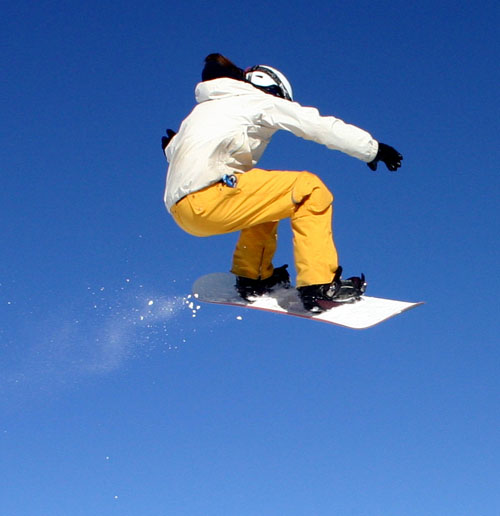It is important when composing shots to try to establish some sort of point of reference for the subject. A snowboarder seen against a clear blue sky may be interesting but the viewer has no way of knowing what was going on or what height the snowboarder reached. Incorporating a bit of the ground, or a jump, helps to put the whole image in its real environment. Many photographers like to get down low so that the snowboarder seems higher up and the jump appears more spectacular. This is a perfectly good, although rather overused, technique. Another approach is to position the camera on the side of the snowboarder where more of the snow from the board is being thrown and try to capture a blast of the flying white stuff to emphasize the speed and action!
|
|
| Image by kind permission of Gary Cowles, USA |
Freezing the movement of fast-moving subject such as snowboarders requires the use of a fast shutter speed. The speed selected depends to some extent upon the direction of the snowboarder's movement relative to the camera. Movement directly towards the camera can be frozen with a slower shutter speed than movement at right-angles to the line of sight. Many photographers choose to use shutter priority mode so that a fast shutter speed is used no matter what the circumstances. Try using 1/2,000 sec and just increase the ISO setting where necessary. A bit of noise is a better option than an unintentionally blurred image. Always remember that the pure-white surroundings are likely to fool an exposure meter in to underexposing the images, so try at least one stop of positive exposure compensation and check image histograms before committing to a particular exposure regime.
Lighting on a snow-covered slope is usually bright and, in direct sun, can be very harsh. Circumstances can be made more difficult by the shape of the terrain and other local conditions, and it may not be easy to place the sun in the best position. Fill flash is a useful, perhaps essential, technique to master. The snowboarder can then be photographed against the light and still be seen correctly illuminated. Without daylight fill flash, the snowboarder may become nothing more than a silhouette.
One final important point, which is also applicable in most other sports, is to get as close as possible to the action as is possible in a safe manner. Filling the frame with the subject, the flying snow and the action is a good basic technique. However other quite different approaches, such as using a fish-eye lens to capture a jump in its real environment of mountains and spectators, can also produce pleasing and unusual shots.







